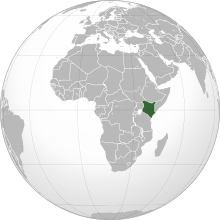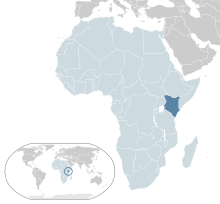Kenya
Republic of Kenya Jamhuri ya Kenya (Script error: The function "name_from_code" does not exist.) | |
|---|---|
| Mošate and largest city | Nairobi 1°16′S 36°48′E / 1.267°S 36.800°E |
| Diteme tsa semmusô | [1] |
| National language | Swahili[1] |
| Merafe ya Batho (2019 census[2]) | |
| Sedumedi (2019 census[2]) |
|
| Demonym(s) | Kenyan |
| Government | Unitary presidential republic |
| William Ruto | |
| Rigathi Gachagua | |
| Amason Kingi | |
| Moses Wetangula | |
| Martha Koome | |
| Legislature | Parliament |
| Senate | |
| National Assembly | |
| Independence from the United Kingdom | |
• Dominion | 12 December 1963 |
• Republic | 12 December 1964 |
| Fatshe | |
• Total | 580,367 km2 (224,081 sq mi)[3][4] (48th) |
• Water (%) | 2.3 |
| Batho | |
• 2022 estimate | 55,864,655[5] (27th) |
• 2019 census | 47,564,296[6] |
• Bokete | 78/km2 (202.0/sq mi) (124th) |
| GDP (PPP) | 2022 estimate |
• Total | |
• Per capita | |
| GDP (nominal) | 2022 estimate |
• Total | |
• Per capita | |
| Gini (2015) | medium |
| HDI (2021) | medium · 152nd |
| Madi | Kenyan shilling (KES) |
| Time zone | UTC+3 (East Africa Time) |
| Date format | dd/mm/yy (AD) |
| Driving side | left |
| Calling code | +254 |
| Internet TLD | .ke |
According to the CIA, estimates for this country explicitly take into account the effects of mortality because of AIDS; this can result in lower life expectancy, higher infant mortality and death rates, lower population and growth rates, and changes in the distribution of population by age and sex, than would otherwise be expected.[10] | |
Kenya, yo e leng Repaboliki ya Kenya semmuso, ke lefatshe le le kwa Botlhaba jwa Aferika. Ke leloko la African Union le le nang le palo ya batho ba ba hetang dimmilone di le 47.7 go ya ka palo batho ya 2019. Kenya o wela mo maemong a masome mabedi le bofererabobedi mo mafatsheng a a nang le palo ya batho e ntsi (28th most populous country) mo lefatsheng, a bo a wela mo maemong a bosupa mo Aforika. Toropon kgolo ya Kenya ke Nairobi e bile ke one motse o mogolo go feta , mme toropo ya bobedi ka bogolo ebile e le e kgologolo ke Mombasa, mme o fitlhelwa mo setlhakatlhakeng sa Mobasa mo lewatleng la india le mafatshe a a mabapi.Mombasa e ne e le toropo kgolo yaBritish East Africa Protectorate, e e neng e akaretsa bophara jwa Kenya le bokone bophirima jwa Somalia go simolola ka 1998 go ema ka 1901. Ditoropo tse dingwe tsa botlhokwa di akaretsa Kisumu le Nakuru. Kenya o dikaganyeditswe ke South Sudan go ya kwa bokone bophirima, Ethiopia go ya kwa bokone, Somalia go ya kwa botlhaba, Uganda go ya kwa bophirima, Tanzania go ya kwa borwa, le Lewatle la Indiago ya kwa borwa botlhaba.
Banni ba ntlha ba Kenya e ne e le batsomi le ba bapadi, jaaka batho ba segompieno ba Hadza.[11][12] Go ya ka nako ya baithutamarope ya dilo tse di amanang le tsone le dilo tsa marapo, batho ba ba buang puo ya Cushitic ba ne ba nna la ntlha mo mafelong a a kwa tlase a Kenya magareng ga 3,200 le 1,300 BC, nako e e itsegeng jaaka Lowland Savanna Pastoral Neolithic. Badisa ba ba buang Se-Nilotic (bagologolwane ba batho ba ba buang se-Nilote ba Kenya) ba simolotse go fuduga go tswa kwa Sudan Borwa ya gompieno go ya kwa Kenya mo e ka nnang ka 500 BC.[13] Batho ba Ba-Bantu ba ne ba nna mo lotshitshing le mo teng ga naga magareng ga 250 BC le 500 AD.[14]
- ↑ 1.0 1.1 Constitution (2009) Art. 7 [National, official and other languages] "(1) The national language of the Republic is Swahili. (2) The official languages of the Republic are Swahili and English. (3) The State shall–-–- (a) promote and protect the diversity of language of the people of Kenya; and (b) promote the development and use of indigenous languages, Kenyan Sign language, Braille and other communication formats and technologies accessible to persons with disabilities."
- ↑ 2.0 2.1 "2019 Kenya Population and Housing Census Volume IV: Distribution of Population by Socio-Economic Characteristics". Kenya National Bureau of Statistics. Archived from the original on 5 June 2020. Retrieved 24 March 2020.
- ↑ "Demographic Yearbook – Table 3: Population by sex, rate of population increase, surface area and density" (PDF). United Nations Statistics Division. 2012. Archived (PDF) from the original on 26 August 2020. Retrieved 4 September 2017.
- ↑ "United Nations Statistics Division – Demographic and Social Statistics". unstats.un.org. Archived from the original on 28 April 2015. Retrieved 4 September 2017.
- ↑ Tempolete:Cite CIA World Factbook
- ↑ "2019 Kenya Population and Housing Census Results". Kenya National Bureau of Statistics. 4 November 2019. Archived from the original on 13 November 2019. Retrieved 15 November 2019.
- ↑ 7.0 7.1 7.2 7.3 "World Economic Outlook Database, October 2022". IMF.org. International Monetary Fund. October 2022. Retrieved December 21, 2022.
- ↑ "Gini index". World Bank Group. 2019. Archived from the original on 4 February 2020. Retrieved 17 June 2021.
- ↑ "Human Development Report 2021/2022" (PDF) (in Sekgoa). United Nations Development Programme. 8 September 2022. Retrieved 8 September 2022.
- ↑ Cite error: Invalid
<ref>tag; no text was provided for refs namedcia - ↑ "African Hunter-Gatherers: Survival, History and Politics of Identity" (PDF). repository.kulib.kyoto-u.ac.jp. Retrieved 2021-10-18.
- ↑ "The East African Bushmen". researchgate.net. Retrieved 2021-10-18.
- ↑ Ehret, C. (1983) Culture History in the Southern Sudan, J. Mack, P. Robertshaw, Eds.
- ↑ "Wonders Of The African World". pbs. Retrieved 2021-10-18.




